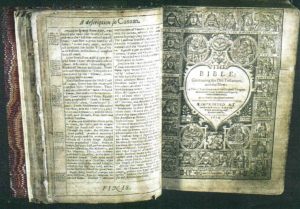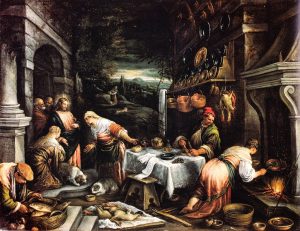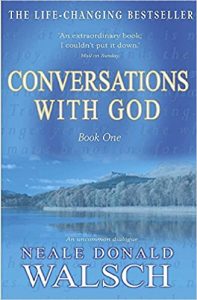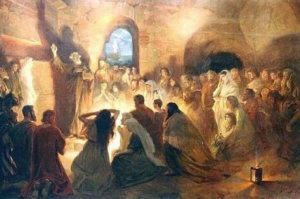A Sermon by the Rev. Dr. Arthur M. Suggs
Preached on Easter Sunday, April 1, 2018
April First Is Fool’s Day, and We Have Butterflies and Moths on the Communion Table.
We did The Good Book (Part 1): Enlightening the Eyes (a.k.a. Bible 101). Then came a sermon on A Hard Conversation: The Use and Abuse of the Bible in Part 2, the Bible and Women in Part 3, the Bible and Homosexuality in Part 4; the Bible and Money in Part 5; and Core Principles of the Bible (Part 6).
Today is a rare day, when both Easter and April Fool’s Day coincide. The last time this happened was in 1956, 62 years ago, and the next one isn’t that far away, in 2029.
Considering the rarity of this coincidence, there are probably tens of thousands of sermons right now about the apparent vacuity of Paul’s Gospel admonition to be fools for Christ, but I’m going to pass on that temptation.
However, our Christian Education Committee has asked me to incorporate the theme of butterflies into the Easter sermon for today.
I’m happy to oblige on one condition, that it will cover both butterflies and moths. The committee undertook my plaintive request after lengthy debate and condescended to my petition upon a close vote.
 On the communion table, we have the National Audubon Society Field Guide to North American Butterflies and Moths, and we have a fantastic coffee-table book called Biophilia: The Human Bond with Other Species by Edward O. Wilson, with marvelous pictures.
On the communion table, we have the National Audubon Society Field Guide to North American Butterflies and Moths, and we have a fantastic coffee-table book called Biophilia: The Human Bond with Other Species by Edward O. Wilson, with marvelous pictures.
There’s an old photograph of a butterfly that I’ll mention later, and the television is cycling fifty-some photos of butterflies that Bernie Lewis has taken over the years.
There’s also what’s called a pysanky, the Ukranian Easter egg with the butterfly theme on it that my wife Tracy did.
To top off the display, in the cases on the piano and also on the communion table are butterflies that were provided by the Price family. So thank you all.
Let me begin with a short poem by Robert Graves, called Flying Crooked:
The butterfly, the Cabbage White,
(His honest idiocy of flight)
Will never now, it is too late,
Master the art of flying straight,
Yet has – who knows so well as I?
A just sense of how not to fly:
He lurches here and here by guess
And God and hope and hopelessness.
Even the aerobatic Swift
Has not his flying-crooked gift.
A Sphinx Moth feeds on a Trumpet; a Beautiful Blue Morpho Saves an Ill Child.

We have all been entranced by the wonder and beauty and delight of butterflies throughout our days.
Perhaps we had a butterfly net as a kid and a meadow to play in, or perhaps we’ve been to the state fair or the Museum of Natural History and have seen the displays of serious collectors.
Or maybe we’ve been sitting in our backyard on a sunny afternoon, and a butterfly alights upon a sleeping dog or baby or flower, demanding our attention and lightening our souls.
It need not be a sunny afternoon. One rather late August night, well after 11:00 p.m., I was sitting in my backyard, having a glass of wine and taking in the night air.
I happened to be sitting next to a trumpet vine, thinking little enough, when suddenly a Sphinx moth, almost indistinguishable in size and flight from a hummingbird, began its nocturnal feeding on those beautiful flowers.
The large moth hovered only a foot or so from my head as I sat still and quiet. I was transfixed by the moment — the rarity of such an encounter; the brrrrrrrrr of the wings right by my ear; the exquisiteness of this little creature of nature, dimly visible in the dark.
 Some of you might have seen The Blue Butterfly (2004). This marvelous movie tells the true story of a terminally ill ten-year-old Canadian boy whose dream is to catch the most beautiful butterfly on earth, the mythic and elusive Blue Morpho.
Some of you might have seen The Blue Butterfly (2004). This marvelous movie tells the true story of a terminally ill ten-year-old Canadian boy whose dream is to catch the most beautiful butterfly on earth, the mythic and elusive Blue Morpho.
His mother, single and frazzled, but determined to grant this last wish of her only child, persuades a renowned entomologist (played by William Hurt) to take them on a trip to the jungles of Costa Rica to search for the butterfly, leading to an adventure that will transform their lives.
I won’t spoil the ending for you but will say only that you will have a tear of joy in your eye.
[Read this omitted section in the full sermon]
Butterflies (and moths to a lesser extent) have been a classic Easter symbol going all the way back.
The way the classic version of it goes is that the caterpillar stage represents our regular human life, and then the cocoon or the chrysalis stage represents our death, reminiscent even of the shroud, the linen cloths wrapped around Jesus’ body.
Finally, after death our soul or spirit emerges into the heavenly realm, the angelic realm, no longer encumbered by physicality, and that is the butterfly stage.
The Caterpillar Doesn’t Die, It Metamorphoses; Follows Death by Resurrection as a Butterfly.

As far as metaphors or analogies go, this isn’t the best of them. For one thing, it’s a bit negative to liken our human experience to that of a worm. I know some people who feel that way. They are glass-half-empty people, but it strikes me as a bit harsh.
However, the caterpillar doesn’t really die but rather changes, called metamorphosis (a Latin word meaning to change from). In any case, really dying is an important part of the Easter message.
This reminds me of an Easter sermon I heard years ago, perhaps memorable because the preacher did not know the difference between two key words — “resurrection” and “resuscitation.”
So he preached an entire sermon about Jesus being resuscitated. “Come on, Jesus, you can make it.” This definitely made the sermon unforgettable.
Despite the butterfly metamorphosis analogy having some weaknesses, the analogy is actually receiving better science that has been discovered of late.
See how the rest of the story unfolds and wraps up…
Download or view the full Good Book (Part 7): Fields and Meadows sermon.
Featured Image Credit: Monarch in the Meadow. Photo by Brett Billings, PD via Pixnio.






















